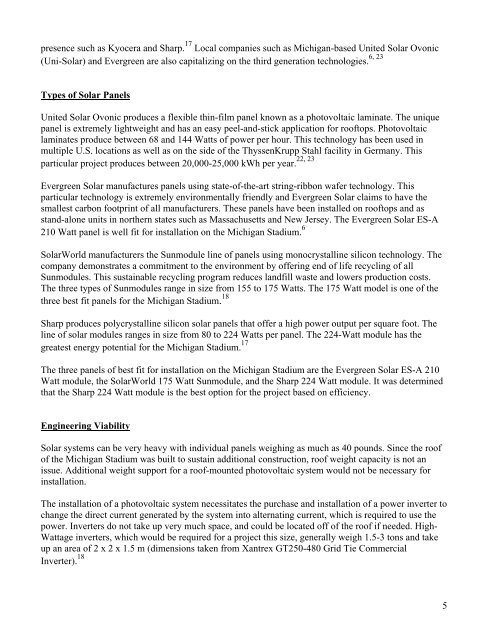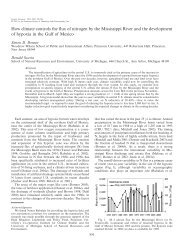2009report-solarstad.. - Graham Sustainability Institute - University ...
2009report-solarstad.. - Graham Sustainability Institute - University ...
2009report-solarstad.. - Graham Sustainability Institute - University ...
Create successful ePaper yourself
Turn your PDF publications into a flip-book with our unique Google optimized e-Paper software.
presence such as Kyocera and Sharp. 17 Local companies such as Michigan-based United Solar Ovonic6, 23(Uni-Solar) and Evergreen are also capitalizing on the third generation technologies.Types of Solar PanelsUnited Solar Ovonic produces a flexible thin-film panel known as a photovoltaic laminate. The uniquepanel is extremely lightweight and has an easy peel-and-stick application for rooftops. Photovoltaiclaminates produce between 68 and 144 Watts of power per hour. This technology has been used inmultiple U.S. locations as well as on the side of the ThyssenKrupp Stahl facility in Germany. This22, 23particular project produces between 20,000-25,000 kWh per year.Evergreen Solar manufactures panels using state-of-the-art string-ribbon wafer technology. Thisparticular technology is extremely environmentally friendly and Evergreen Solar claims to have thesmallest carbon footprint of all manufacturers. These panels have been installed on rooftops and asstand-alone units in northern states such as Massachusetts and New Jersey. The Evergreen Solar ES-A210 Watt panel is well fit for installation on the Michigan Stadium. 6SolarWorld manufacturers the Sunmodule line of panels using monocrystalline silicon technology. Thecompany demonstrates a commitment to the environment by offering end of life recycling of allSunmodules. This sustainable recycling program reduces landfill waste and lowers production costs.The three types of Sunmodules range in size from 155 to 175 Watts. The 175 Watt model is one of thethree best fit panels for the Michigan Stadium. 18Sharp produces polycrystalline silicon solar panels that offer a high power output per square foot. Theline of solar modules ranges in size from 80 to 224 Watts per panel. The 224-Watt module has thegreatest energy potential for the Michigan Stadium. 17The three panels of best fit for installation on the Michigan Stadium are the Evergreen Solar ES-A 210Watt module, the SolarWorld 175 Watt Sunmodule, and the Sharp 224 Watt module. It was determinedthat the Sharp 224 Watt module is the best option for the project based on efficiency.Engineering ViabilitySolar systems can be very heavy with individual panels weighing as much as 40 pounds. Since the roofof the Michigan Stadium was built to sustain additional construction, roof weight capacity is not anissue. Additional weight support for a roof-mounted photovoltaic system would not be necessary forinstallation.The installation of a photovoltaic system necessitates the purchase and installation of a power inverter tochange the direct current generated by the system into alternating current, which is required to use thepower. Inverters do not take up very much space, and could be located off of the roof if needed. High-Wattage inverters, which would be required for a project this size, generally weigh 1.5-3 tons and takeup an area of 2 x 2 x 1.5 m (dimensions taken from Xantrex GT250-480 Grid Tie CommercialInverter). 185










